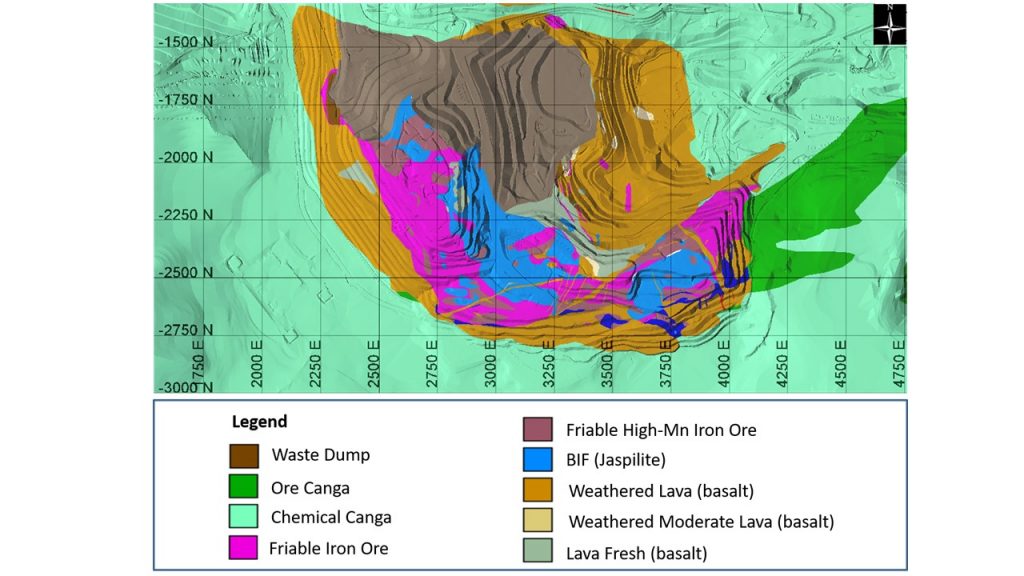05 – MANGANESE MINERALS FROM N5W IRON ORE MINE, CARAJÁS
Ano 07 (2020) – Número 01 Artigos
![]() 10.31419/ISSN.2594-942X.v72020i1a5LCGC
10.31419/ISSN.2594-942X.v72020i1a5LCGC
Luiz Cláudio G. da Costaa, Marcondes Lima da Costab*, Carlos Eduardo Reinaldo Delgado c
aVale S.A., Carajás, Pará, Brazil, when he was completing the completion of PPGG / IG / UFPA in the period 2013-2015, lcgcosta@yahoo.com.br.
b PPGG/Instituto de Geociências, Universidade Federal do Pará – UFPA, Belém – Pará, Brasil, marcondeslc@gmail.com, https://orcid.org/0000-0002-0134-0432
cVale, S.A., Carajás, Brazil. carlos.delgado@vale.com.
*Corresponding author
ABSTRACT
Manganese minerals are frequently found in the N5W mine, Carajás and is considered the main impurity in their high-grade iron ore. This kind of occurrences are also known in several iron ore mines around the world and are referred to diversified origins. The present work presents and discusses the presence of these minerals in N5W mine, regarding the mode of occurrence and mineralogical characterization, carried-out by mineral characterization, petrographic analysis, X-ray diffraction and scanning electron microscopy (SEM). Pyrolusite, bixbyite, ramsdellite, cryptomelane chalcophanite and hollandite usually occur filling veins, venules, fractures and gaps on the high-grade iron ore, however cryptomelane and hollandite are also founded as small lenses on the banded jaspilites. Therefore, we propose that the specific association of manganese minerals found in the veins and in the fractured zones may be related to the tectonic remobilization of preexisting Mn minerals, such as the cryptomelane and hollandite lenses of jaspilites that, in its turn, can derive or are related to volcanic to subvolcanic mafic rocks that hosts the Carajás iron formations.
Keywords: contaminants; pyrolusite; bixbyite; ramdsllite; hollandite; jaspilite; gabbro; basalt.
INTRODUCTION
The Carajás Mineral Province (CMP) stands out on the world stage for its giant high-grade iron ore deposits (> 65% Fe), discovered in 1967 and mined since 1985 at Serra Norte mines, later in the Serra Leste and Serra Sul mines. The iron ore are in general associated with lateritic supergenic deposits, which are overlapped by lateritic iron crusts, inadequately called canga. The supergenic ore was derived from the Jaspilites of the Carajás Formation, of Archean age affected by tectonic deformations and sectioned by dikes and sills of mafic rocks (Beisiegel et al., 1973; Costa, 1997; Biondi, 1999; Costa, et al., 2011; Costa et al., 2013; Silva & Costa, 2020). The iron ore on N5W mine is mainly made up of friable hematite, with subordinated amounts of possible hydrothermal compact hematite, that locally contain relatively high contents of Mn, P and Al (Costa et al., 2013).
Manganese minerals commonly occur associated with banded iron formations (BIF’s) around the world, sometimes being able to form deposits. At the Ghorabi – Nasser iron mine in Egypt, manganese minerals are one of the main impurities (Baioumy et al., 2012) and are considered of supergenic origin due to its botryoidal forms. Mn minerals can also form ferro-manganese deposits, such as Umm Bogma (Saad & Zidan, 1994) and at Koira-Noamundi province in India, that represent exhalation phases of fissural volcanism (Mohapatra et al., 2009). At Urucum mine, Mato Grosso do Sul, Brazil, three major manganese lenses occur intercalated with BIFs, forming a rich deposit of the two commodities (Biondi & Lopez, 2017; Biondi et al., 2020).
The present work was dedicated to map the different modes of occurrence of Mn minerals within the N5W iron mine, identify them and discuss their relationship with the modes of occurrence, in order to unveil their possible origin.
The N5W mine is located at Serra Norte complex, Carajás, southeastern Pará, 45 km from the Carajás Village, Parauapebas municipality, State of Pará (Figure 1).
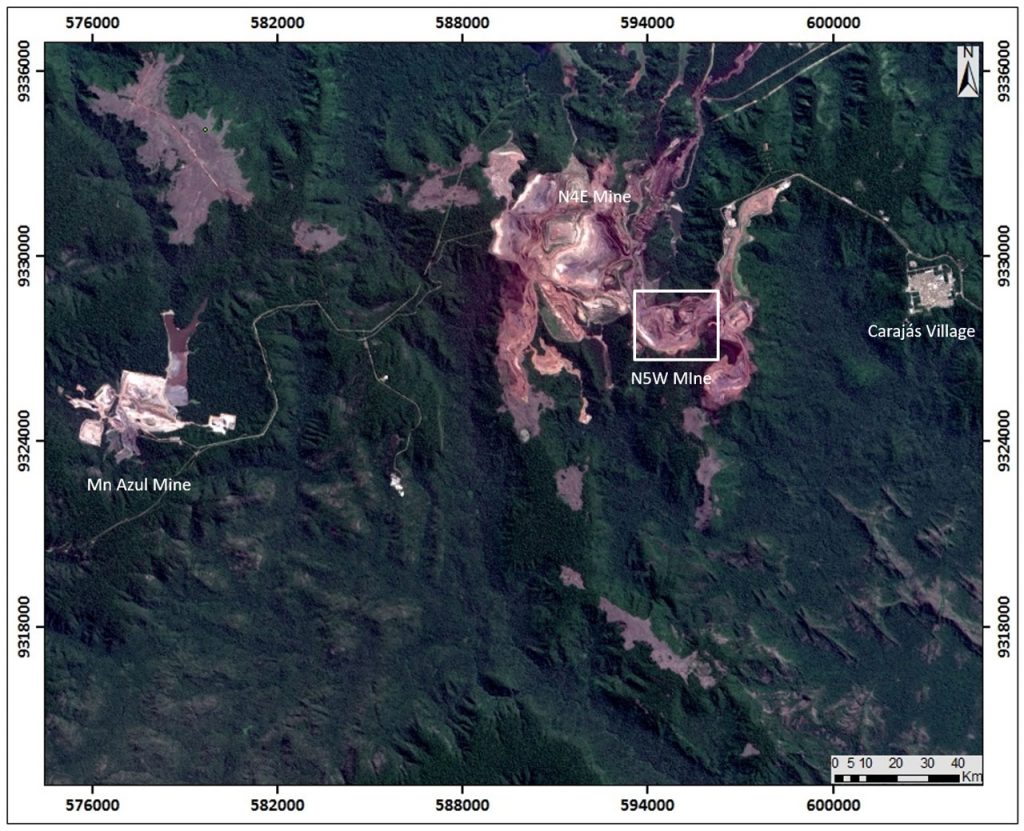
Figure 1 – Satellite image showing the main iron deposits of Serra Norte, detaching the mine N5W (white quadrangle) in the image-center. Geoeye images from 2018.
GEOLOGICAL SETTING
The N5W mine is located on Central Amazon geochronological province (Tassinari & Macambira, 1999) of the Amazonian Craton and comprehend their most ancient Archean nuclei. These province is traditionally subdivided into two domains: The Rio Maria granite-greenstone terrain on the south (Dall’Agnol et al., 1996) and the Itacaiúnas Belt (Araújo et al. 1988) on the north, where the CMP are founded.
The Rio Maria granite-greenstone terrain (3.05 – 2.85Ga) comprise the Andorinhas Greenstone Belt (DOCEGEO 1988), and granitic intrusions (Rio Maria Granodiorite, Mogno Trondhjemite and Parazônia Tonalite).
The Itacaiúnas Belt involves the Xingu and Pium complexes (Araújo et al. 1988; DOCEGEO 1988), the Estrela Gneiss, the Plaquê Suite and the Sapucaia and Grão-Pará groups, the latter containing the Carajás Formation, which bears the supergenic iron proto-ores, the jaspilites.
The CMP’s lands were affected by the Itacaiúnas Shear Belt, formed to the north, by the Carajás and Cinzento transcurrent systems (Figure 2), with the development of an elongated sigmoid in the direction WNW-ESSE (Araújo et al., 1988 and Araújo & Maia, 1991). Recently, Galbiatti et al. (2017) proposed a compressional N-S tectonic event with vergence to the south to the Grão Pará Tectonic Domain, that are responsible to form E-W structures as banding and fold axes.
Manganese manifestations in the CMP are expressive at the level of deposits, exemplified by the Azul mine, in which the ore is associated with manganese and pelitic siltstones, therefore sedimentary, which were partially enriched by paleotropical weathering (Costa et. Al., 2005), in the same way as the iron ore Silva & Costa, 2020). Also noteworthy are the supergenic manganese deposits in Buritirama (Salgado et al., 2019), in addition to small deposits in Sereno (Serra Pelada) and Buriti.
MATERIALS AND ANALYTICAL METHODS
Thirty-five samples of Mn-bearing iron ores (mining front and drill holles) were collected and analyzed by optical microscope in polished sections (9 samples), by X ray diffraction (XRD) (29 samples) and scanning electron microscope (SEM) coupled to energy dispersive x ray spectrometry (EDS) (5 samples).
The XRD mineralogical identification was carried out by XRD technique, powder method, using a PANalytical diffractometer, model X’PERT PRO MPD (PW 3040/60) with a goniometer PW 3050/60 (theta-theta) equipped with a copper anode (λCu Ka = 1.5406 Ǻ); operating conditions of 40 kV and 35 mA, detector type RTMS, X’Celerator. The data acquisition was performed using the X’Pert Data Collector software, version 2.1a. The data XRD data were processed with X’Pert HighScore version 2.1b. These analyzes were performed at the Mineralogical Characterization Laboratory (MCL) of Geosciences Institute of the Federal University of Para (UFPA).
The SEM/EDS analyzes were used to observe the morphological and mineralogical characteristics of the Mn-bearing iron ores in polished thin sections, using backscattered (BSE) images. The thin sections were previously coated with gold for 2 minutes with a coating thickness of 15 nm for EDS analyzes. For backscattered electron images the polished thin sections were metalized with carbon. A LEO ZEISS SEM (model 1430) with a Sirius-Gresham EDS detector belonging to the Laboratory of Scanning Electron Microscopy of the UFPA were used. Operating conditions for the BSE images and the EDS analysis were: electron beam current of 90 μA, acceleration voltage of 20 kV, work distance of 15 mm and scanning time of 30 s with 3000 to 4000 cycles per second (c/s) for each analysis.
RESULTS AND DISCUSSIONS
Mine Geology
At the current (year 2018) pit level of the N5W mine, the jaspilites (iron ore protoliths) from the Carajás Formation and basalts that constitute the Parauapebas and Cigarra formations of the Grão Pará Group were exposed (Figure 2). These rocks are indistinctly sectioned by gabbro dikes (Figure 3). The iron ore is predominantly friable (HF, friable hematite), and occurs in tabular hematite aggregates, in which millimeter-sized octahedrons are frequent, suggesting hematite pseudomorphic after magnetite (known as martite) and microcrystalline quartz (Figure 4 A). When that ores contains manganese oxy-hydroxides, they tend to have a greenish brown color (Figure 4 B), an aspect that allows, in part, to recognize the Mn contamination. Taken as a whole, it ranges from a tabular to micro laminar and then earthy sequence towards the top of the pit. Few relic blocks of jaspilites can occur inside the package of friable hematite, whose size decreases towards the top of the pit (Figure 4 C), in direct relation to the increase in the degree of supergenic alteration of the jaspilites and associated rocks. The jaspilite bodies have similar structural pattern compared to the friable, placoid hematites, demonstrating that they originated from the paleotropical weathering over the jaspilite. These features demonstrate correspondence to the saprolitic zone of the lateritic alteration profiles. Blocks of basalts still fresh, likewise, also occur in this zone, and certainly contribute to the insertion of Al, P and Ti in the alteration profile, which were released from aluminosilicates, mafic and apatite, when weathered. Along the contact zone of the gabbroic intrusions, a slight increase in the content of manganese minerals is observed, suggesting that these dykes possibly served as conduits for remobilization and percolation of fluids rich in Mn oxy-hydroxides (Figure 3).
Large bodies of compact hematites, although restricted, usually have plane-parallel lamination and appear to have a formation prior to the supergenic alteration.
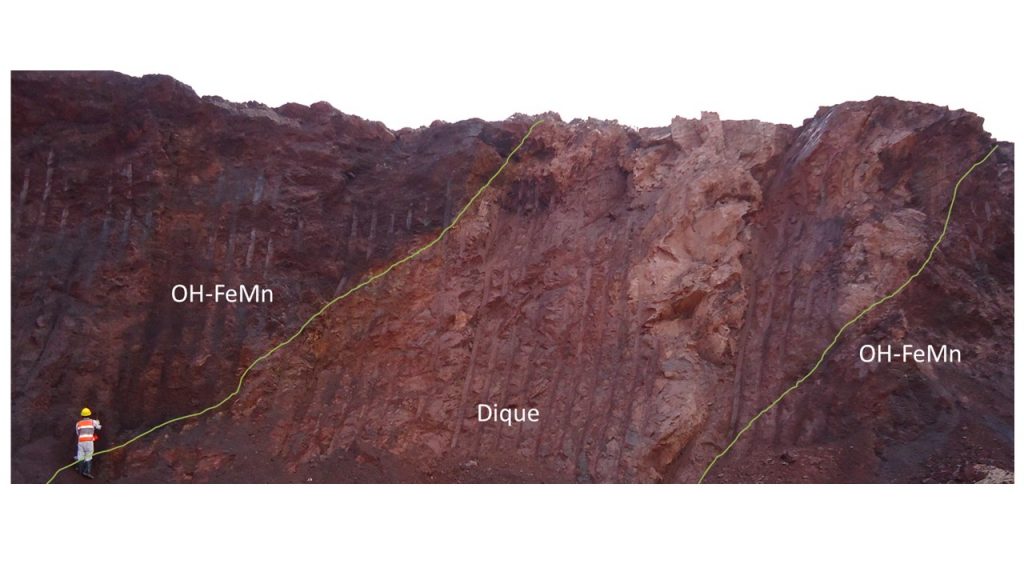
Figure 3 – A dyke of mafic rock (gabbro) deep weathered (saprolite zone), which cross cut the Mn-bearing iron ore in the mine N5W. OH-FeMn: iron-manganese oxyhydroxides. Dique: dyke. The high of the pit bench:15 m.
The mine geological mapping also allowed to identify lineaments and faults whose main directions are NW-SE and NE-SW, in addition to other N-S, less frequently, which correspond to regional features. Certainly, they must have been at least partly responsible for the remobilization and consequent precipitation of Fe and Mn oxyhydroxides and microcrystalline quartz along the voids they created, giving rise to the numerous veins filled with these minerals.
The banding of the N5W jaspilites is conferred by the alternation of hematite bands with those of microcrystalline quartz plus hematite (jasper), which varies from planar to wavy, discontinuous, but persistent (Figure 5). Their thickness is variable, from 1 to 6 mm, individually they may also contain thinner bands, micro bands, plane-parallel to irregular (Figure 5 A and B). They can also show micro lenses, or converge to the domain of pods, suggesting tectonic deformation (Figure 5 D), such as stretching or compression. The darker bands (Figure 5 C and D) demonstrate the presence of microcrystalline Mn oxyhydroxides interspersed with those of Fe. Locally the hematite bands are rich in octahedra suggestive of magnetite alongside carbon material, apparently amorphous (Figure 5 E and F).
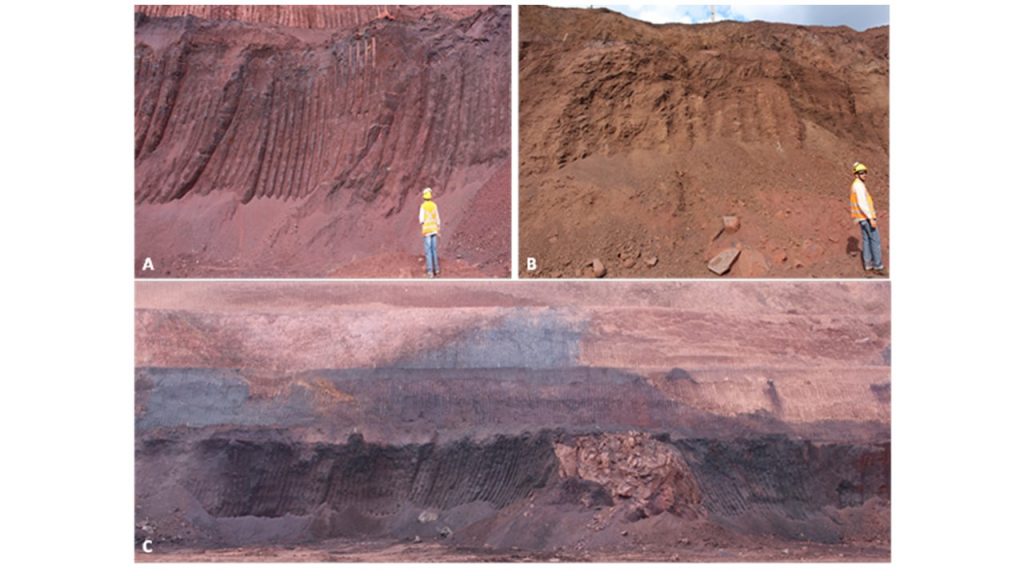
Figure 4 – (A) Mining bench showing the friable to powdery rich iron ore, of brownish to dark gray color, partly laminated (Fe> 65%); (B) Mining bench displaying the friable Mn-bearing iron ore with OH-Mn brownish in color; (C) A large block (boulder) of fresh jaspilite within the platelet or placoid black hematite iron ore. Each bench is 15 meters high.
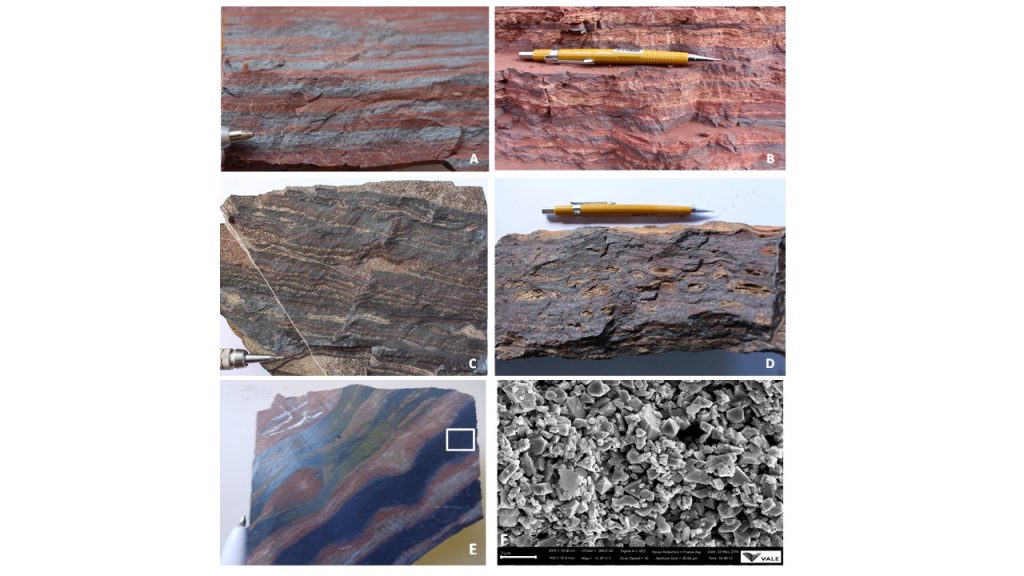
Figure 5 – (A and B): A typical hand samples of jaspilites in N5W mine: microbands of fine hematite-rich chert interstratified with gray to dark gray bands of hematite and magnetite; (C): A quasi black jaspilite bands rich in manganese oxy-hydroxides intercalated with very thin jasper bands; (D): A small jaspilite hand sample strong deformed showing discontinuous bands and pods; (E): Also a small hand sample of jaspilite formed by magnetite-rich uneven bands associated with carbon-rich material and jasper; (F): SEM image showing a detail of a magnetite-rich band detaching octahedral crystals. Scale in the SEM image: 3 µm.
Mineralogy
The main manganese minerals identified by XRD (Figure 6) and supported by SEM/EDS were: pyrolusite, bixbyite, cryptomelane, hollandite, braunite, ramsdellite and chalcofanite, all Mn oxyhydroxides, except for braunite, that comprises a silicate (Figure 6; Table 1). In N5W most of these minerals, pyrolusite, bixbyite and braunite, sometimes cryptomelane, are preferably found in the fault zones, such as veins, contact zones and gaps, while cryptomelane and hollandite in small and thin lenses.
Throughout fracture and shear zones, right in the contact zone with mafic intrusion that section the jaspilites and iron ore (Figure 3), OH-FeMn were observed in the same situation in the drill hole cores N5W-FD01386, highlighting if pyrolusite and, to a lesser extent, hollandite and/or cryptomelane, in addition, of course, hematite as the most abundant mineral, followed by goethite and microcrystalline quartz.
In Carajás, Medeiros Filho et al. (1994) have already observed that the manganese occurrences of the N4 and N5 mines are structural controlled by faults, shearing, tectonic contacts and also near the mafic rocks.
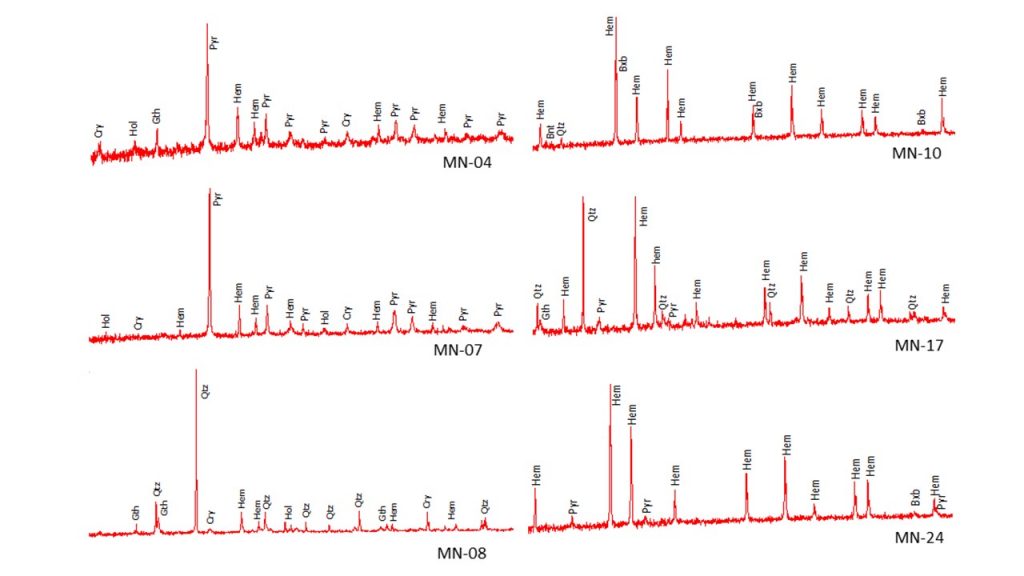
Figure 6 – Manganese minerals and others identified by XRD in the N5W mine in Carajás. Hematite (Hem); goethite (Gth); cryptomelane (Cry); ramsdelite (Rdl); braunite (Bnt); bixbyite (Bxb); pyrolusite (Pyr) and quartz (Qtz). Samples: MN-04, MN-10, MN-07 E MN-08.
A polished slide under the optical microscope confirms the transformation of octahedral magnetite into hematite (pseudomorphic substitution) (Figure 7 A, C and D), as well as the formation of goethite and the presence of a fourth micro to cryptocrystalline (Figure 7 B).

Figure 7 – (A): Trigonal idiomorphic crystal of hematite and rhombohedral of magnetite or hematite after magnetite in a microcrystalline domain of tabular hematite, in addition to plasma of goethite (brown) and quartz (dark gray background); (B): the goethite domain (brown) and the chalcedonic quartz bands (white) with cryptocrystalline hematite (black); (C): detail of the hematite trigonal crystal in (A) partially replaced by goethite; (D) detail of the rhombohedral crystal still with reliquary portions of the magnetite, but largely replaced by hematite; in its surroundings goethite (brown) and hematite (light gray) and quartz (dark gray).
The microcrystalline intergrowth between iron and manganese minerals is much clearer in SEM images (Figure 8). Hematite appears in a lamellar pattern, sometimes in irregular contact with manganese minerals, such as pyrolusite, when it takes on a fibrous appearance and is associated with cryptomelane (Figure 8 A). Here cryptomelane seems to involve and replace hematite, while in Figure 8 B micrometric tabular crystals of hematite advance over cryptomelane. Sections of octahedron and masses of magnetite project into the cryptocrystalline mass of hematite and perhaps Mn oxyhydroxides (Figure 8 C). It is also possible to identify relics of magnetite within its crystal, which has been largely transformed into hematite (Figure 8 D).
As usually occurs with pyrolusite, it is presented here in intricate crystal aggregates (Figure 9 A), whose identification is confirmed by the analytical spectrum of EDS (Figure 9 B). Morphological analyzes (Figure 9 C) supported by the chemical spectrum of EDS (Figure 9 D) also confirm the presence of hollandite, which developed within a cryptocrystalline pyrolusite mass. Therefore, the microscopic data clearly shows the microcrystalline intergrowth between the manganese and iron minerals in the jaspilite microbands.
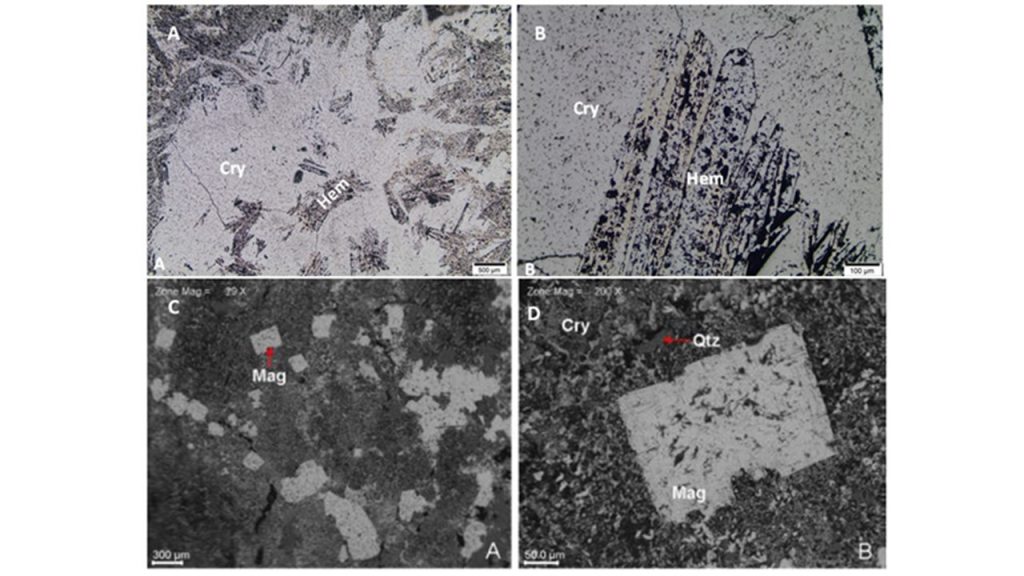
Figure 8 – (A): Mass of cryptomelane (Cry) advancing on tabular hematite (Hem); (B): detail of the tabular crystals of hematite (Hem) within the cryptomelane mass (Cry); (C): octahedral crystals and masses of magnetite (Mag) in a cryptocrystalline matrix of hematite (gray) and perhaps cryptomelane (gray); (D): An enlarged cross section of deformed magnetite octahedron (Mag), probably including microcrystalline quartz (Qtz) in a matrix of tabular hematite, quartz and cryptomelane (Cry).
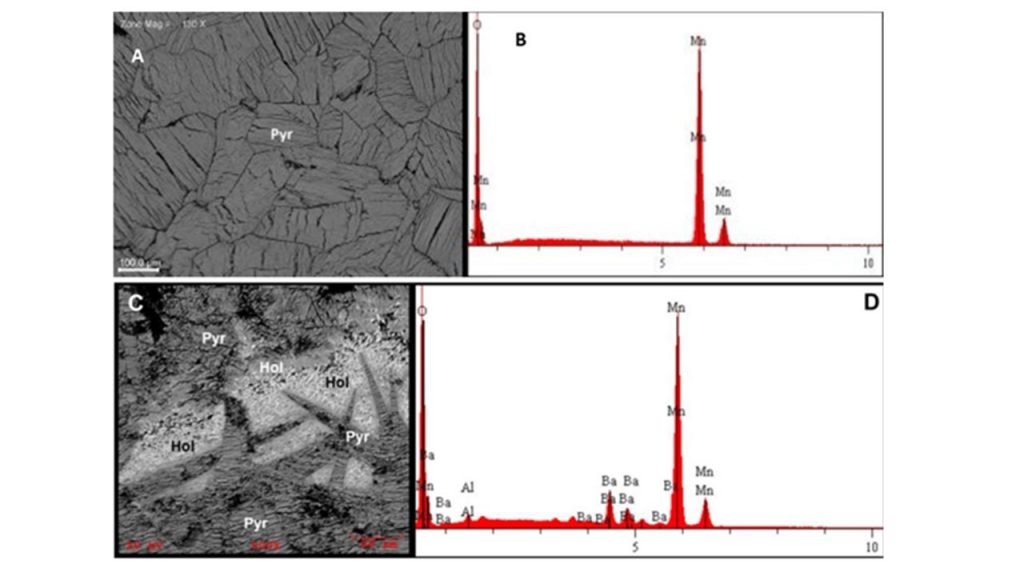
Figure 9 – (A): Intricate aggregates of pyrolusite crystals (Pyr); (B): its respective EDS chemical spectrum, showing the presence of only Mn and O, equivalent to MnO2; (C): partial outline monoclinic crystals of hollandite (Hol) that develop from a cryptocrystalline pyrolusite mass (Pyr); (D): the analytical spectrum of hollandite, confirmed by the presence of Mn, O and Ba.
The manganese minerals of the N5W iron mine basically comprise two domains: those of micro lenses, cryptomelane and hollandite, which are the main minerals in the sedimentary rocks of Azul deposits and can therefore be classified as earlier diagenetic (Table 1). These minerals can also be found in other environments. Therefore, in N5W, these two minerals next to the main minerals of iron ore, hematite and magnetite, at least magnetite, in its relatively large idiomorphic crystals, would have to be diagenetic. The other manganese minerals identified (Table 1) are clearly related to areas of tectonic deformation, housed in fractures, faults and fault gaps, which do not characterize them as classic hydrothermal vents, but as mobilized and precipitated from aqueous solutions heated in these zones, contained iron formations, which is still local tectonic-induced hydrothermal system. Those along the contact between the mafic dykes and the iron ore, could be considered as of hydrothermal origin, due to the heat emanating from the mafic body and aqueous solutions also contained in the iron formations. The only ones that could still be considered partly supergenic (lateritic) would be pyrolusite, cryptomelane and hollandite, perhaps ramsdellite (Table 1), which, however, was not clearly observed.
Table 1 – The main manganese minerals identified in N5W mine and their possible genetic environment by correlation with literature information.
| Minerals | Chemical formula | Genetic environments |
| Pirolusite | Mn4+O2 | Supergenic and hydrothermal (1, 2) |
| Bixbyite | (Mn, Fe)2O3 | Hydrothermal (1, 3) |
| Criptomelane | K(Mn3+, Mn4+)8O16 | Supergenic, diagenetic and hydrothermal (1) |
| Hollandite | Ba(Mn2+, Mn4+)8O16 | Supergenic (1), diagenetic, metamorphic (3), hydrothermal (3) |
| Braunite | Mn7SiO12 | Hydrothermal (1), diagenetic (3), metamorphic (3) |
| Calcofanite | ZnMn3O73.H2O | Hydrothermal and supergenic (1) |
| Ramsdellite | Mn4+O2 | Hydrothermal (?) |
(1) Nicholson (1992); (2) Hein et al. (1997); (3) Gutzmer & Beukes (1996).
CONCLUSIONS
The manganese minerals in the N5W iron ore mine are established in fault plans and fractures, mainly at the central-west portion of the mine, which were still installed at the time of the fresh jaspilites, as it was possible to show in some drill holes. These minerals also persist in these same structures throughout the thick high-grade ore package that resulted from the lateritic weathering, saprolite zone, of the jaspilites, the proto-ores with the contribution of basalt and related gabbro. The Mn minerals are also found as small lenses within proto-ore, and can be interpreted as sedimentary or diagenetic in origin, as well as hydrothermal in the contact between mafic rocks and jaspilite, and partly as a result of the weathering, also incorporated in the supergenic iron ore.
The main minerals of Mn are bixbyite, pyrolusite and braunite, followed by cryptomelane, hollandite, chalcophanite and ramsdellite. With the exception of cryptomelane and hollandite, which are typical of jaspilite lenses, the others are found in the zones of faults, fractures and gaps, as well as in the mafic-proto-mineral-ore contact zone, which can be considered hydrothermal-tectonic and low-hydrothermal. temperature. Pyrolusite, cryptomelane and hollandite, partly ramsdellite, could still be of supergenic (lateritic) origin. Taken together, these minerals are all seen in the iron mine as contaminating minerals.
Acknowledgments
The authors are grateful for the field support given by the company Vale S/A at the time of the development of the master’s degree of the first author (Costa, L.G.C.), as an employee of this company; to the laboratories of the Geosciences Institute for analytical support; and CNPq for financial support to the second author (Grant 304333 / 2003-4) and for the general support granted by the GEOCIAM project (Edital 015/2008 – 2009/2016).
REFERENCES
Araújo, O. J. B., Maia, R.G.N., Jorge João, X.S., Costa, J.B.S. 1988. A megaestruturação arqueana da Folha Serra dos Carajás. In: Congresso Latinoamericano de Geologia, 1, Anais, p. 324-338.
Baioumy, H.M., Gilg, H.A., Taubald, H. 2012 Mineralogy and Geochemistry of the Sedimentary Kaolin Deposits From Sinai, Egypt: Implications for Control by the Source Rocks. Clays and Clay Minerals 60(6):633-654. http://dx.doi.org/10.1346/CCMN.2012.0600608
Beisiegel, V.R., Bernardelli, A.L., Drummond, N.F., Ruff, A.W., Tremaine, J.W. 1973. Geologia e recursos minerais da Serra dos Carajás. Revista Brasileira de Geociências, 3:215-242.
Biondi, J. C. 1999. Distribuição no Tempo Geológico dos Principais Depósitos Minerais Brasileiros: 2. Épocas Metalogenéticas. Revista Brasileira de Geociências. 29(4):517-526.
Biondi, J.C. & Lopez, M. 2017. Urucum Neoproterozoic–Cambrian manganese deposits (MS, Brazil) Biogenic participation in the ore genesis, geology, geochemistry, and depositional environment. Ore Geology Reviews, 91 (2017) 335-386. doi:10.1016/j.oregeorev.2017.09.018.
Biondi, J.C., Polgári, M., Gyollai, I., Fintor, K., Kovács, I., Fekete, J., Mojzsis, J. 2020. Biogenesis of the Neoproterozoic kremydilite manganese ores from Urucum (Brazil) – A new manganese ore type. Precambrian Research, 340 (2020) 105624. doi:10.1016/j.precamres.2020.105624.
Costa, L.C.G. 2015. Minerais de Manganês como Contaminantes do Minério de Ferro na Mina N5w em Carajás, Pará. Master Dissertation, PPGG/IG-Federal University of Pará, Belém, 72p.
Costa L.C.G., Costa M.L., Farias H.D., Couto A., Galbiatti, F., Braga M.A.S. 2013. Os minerais contaminantes do minério de ferro de N5W, Carajás-PA: oxi-hidróxidos de Mn e sílica. In: Simpósio de Geologia da Amazônia, 13., 2013. Recursos minerais e sustentabilidade territorial na Amazônia, p. 671-674.
Costa, M.L., Choque Fernandez, O. J., Requelme, M.E.R. 2005. O depósito de manganês do Azul, Carajás: Estratigrafia, mineralogia, geoquímica e evolução geológica. In: O. J. MARINI et al. (orgs.) – Caracterização de depósitos minerais em distritos mineiros da Amazônia. P. 231-333.
Costa M.L., Queiroz J.D.S., Silva A.C.S., Almeida H.D.F., Costa L.C.C. 2011. Perfil Laterítico Desenvolvido Sobre Formação Ferrífera Bandada (Jaspilito) em Carajás. In: Simpósio de Geologia da Amazônia, 12., 2011, Boa Vista. Annals…, p. 403-407.
Costa, M.L. 1997. Lateritisation as a major process of ore deposit formation in the amazon region. Explor. Mining Geol., 6 (1): 79-104.
Dall’Agnol R., Souza Z.S., Althoff F.J., Macambira M.J.B., Leite A.A.S. 1996. Geology and geochemistry of the Arquean Rio Maria Granite-Greenstone Terrain, Carajás Province, Amazonian Craton. In: Symp. Archean Terranes South American Plataform. Extended abstracts, Brasília, SBG, p. 29-30.
DOCEGEO. 1988. Revisão litoestratigráfica da Província Mineral de Carajás. In: SGB, Congresso Brasileiro de Geologia, 35, Anais, p. 10-54.
Galbiatti, H. F.; Endo, I.; Delgado, C. E.R., Zapparoli, A. C.; Carlos, D. U.; Pereira, W. R.; Assis, L. M.; Costa, L. C. G.; Moreira, G. M.; Oliveira, M. M. F., 2017. Estruturação Tectônica sob Regimes Compressionais na Província Mineral de Carajás – Estado do Pará – Brasil. Anais. XV Simpósio de Geologia da Amazônia. Belém – Pará. 196-200 p.
Gutzmer, J., Beukes, N.J. 1996. Mineral paragenesis of the Kalahari manganese field, South Africa. Ore Geol. Rev. 11, 405–425.
Hein, J.R., Koschinsky, A., Halbach, P., Manheim, F.T., Bau, M., Kang, J.K., Lubick, N. 1997. Iron and manganese oxide mineralization in the Pacific. In: Nicholson, K., Hein, J.R., Buhn, B., Dasgupta, S. (Eds.), Manganese Mineralization: Geochemistry and Mineralogy of Terrestrial and Marine Deposits: Geol. Soc. Spec. Publ., 119, pp. 123–138.
Medeiros Filho C.A., Santos A.B., Brauer E.H., Cordeiro J.R.C., Fernandes E. 1994. Significado da Distribuição de Mn e Al nos Minérios de Ferro na Parte Norte do Depósito de N4W – Carajás. In: 4º Simpósio de Geologia da Amazônia, Anais, Belém, SBG, Núcleo Norte, p. 359-362.
Mohapatra, B.K., Mishra, P.P, Singh, P.P. 2009. Manganese ore deposits in Koira-Noamundi province of Iron Ore Group, north Orissa, India: In the light of geochemical signature. Chemie der Erde – Geochemistry 69(4):377-394. DOI: 10.1016/j.chemer.2009.06.001.
Nicholson, K. 1992. Contrasting mineralogical–geochemical signatures of manganese oxides: Guides to metallogenesis. Econ. Geol. 87, 1253–1264.
Saad, N.A. B.I., Zidan, K.I. 1994. Khalil Geochemistry and origin of the manganese deposits in the Umm Bogma region, west central Sinai, Egypt J. Afr. Earth Sci., 19: 109-116.
Salgado. S. S., Caxito. F.A., Queiroga. G.N., Castro. M.P. 2019. Stratigraphy, petrography and tectonics of the manganese-bearing of the Buritirama Formation. Northern of Carajás Domain. Amazon Craton. Brazilian Journal of Geology. 49(1): 1-15. Doi: 10.1590/2317-4889201920180106.
Silva, A.C.S., Costa, M.L. 2020. Genesis of the “soft” iron ore at S11D Deposit, in Carajás, Amazon Region, Brazil. Braz. J. Geol. (2020), 50: e20180128. DOI: 10.1590/2317-4889202020180128.
Tassinari, C.C.G., Macambira, M.J.B. 1999. Geochronological provinces of the Amazonian Craton. Episodes, 22:174-182.

